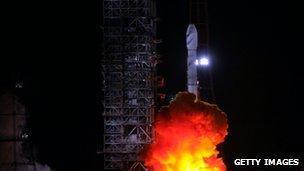Questions over Chinese satellites 'to monitor sea'
- Published

China is building its own navigation and positioning satellite network
A UK scientist has questioned China's plans to send eight satellites into space to monitor the ocean around the country.
The nation already has three maritime satellites in orbit.
Prof John Walker of the Nottingham Trent University said adding eight more was "a very significant investment just to monitor water".
"I would expect the real value of these satellites to be more military and intelligence gathering," he said.
Prof Walker has previously worked at the Royal Signals and Radar Establishment, the UK's former scientific research body within the Ministry of Defence.
Currently, China's sea-monitoring system covers about 300,000 sq km (115,000 sq miles) of ocean around the country, according to the country's State Oceanic Administration.
National Satellite Ocean Application Service director Jiang Xingwei told the China Daily, external newspaper the new satellites had already been approved by the National Development and Reform Commission.
Four of them will observe the colour of the sea, two will monitor currents, and two will be radar satellites.
They may also be used for better monitoring of the disputed Diaoyu Islands, also known as Senkaku in Japan.
Japan controls the islands, which lie south of Okinawa, but China also claims them, as does Taiwan to the south.
Space programme
In 2011, China announced it would send 100 rockets and 100 satellites into orbit by 2015, with a target of 20 launches a year.
The country's ambitious space programme includes manned missions, developing technologies for spacewalking and docking, and eventually building China's own space station.
Eight Chinese nationals have now been in space since 2003, and in July this year, astronauts on the Shenzhou-9 spacecraft successfully docked with the Tiangong-1 lab module.
The country is also building its own navigation and positioning satellite network, called Beidou.
It has several navigation satellites in orbit already, but to have global coverage China plans to have 35 of them in total by 2020.
- Published24 June 2012
- Published30 April 2012
- Published28 October 2011